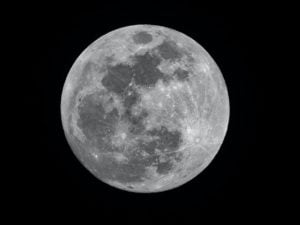
Space memorabilia is a consistently solid market and there is no shortage of collectors interested in NASA artifacts. This usually consists of autographed photographs, blueprints, tapes, astronaut equipment or even physical pieces of the spacecraft themselves. However, all that pales in comparison to actually acquiring a piece of another world. Specifically, most collectors would give away their entire catalogue in exchange for acquiring a rock or even dust from the moon.
The Moon is orbiting the Earth from an average distance of 250,000 miles and is unreachable to anyone lacking the technology to break away from the Earth’s escape velocity. As a result, all the current lunar material on this planet comes from three sources:
- Lunar Meteorites: Lunar material can naturally be found on Earth after impact events on the Moon eject material that goes into terrestrial orbit and eventually passes through our atmosphere. Around 420 lbs. (190 kg.) of lunar materials have been found, to date exclusively in desert regions in northern Africa, Oman and Antarctica. The authenticity of the material is usually verified by comparing its composition to lunar samples collected from the U.S. or Soviet moon missions. These meteorites are perfectly legal to collect and sell on the open market and often command extremely high prices at auction. On October 19, 2018, RR Auction in Boston, MA announced that the winning bid for a 12 lb. of lunar meteorite material was $612,500.00, purchased by a buyer in Vietnam.
- Soviet Union Luna Program: Between 1970 and 1976, three unmanned probes landed, collected and returned 10.7 oz. (301 grams) of lunar material to Earth. The vast majority of this material is still stored somewhere within the Russian government. However, the U.S.S.R. once gifted a portion of this lunar sample to Nina Ivanovna Koroleva, the widow of former Soviet space program director Sergei Pavlovich Korolev, in recognition of her husband’s contributions to the program. On November 28th, 2018, this sample was auctioned at the Sotheby’s auction house in New York and sold for $855,000 to an American private collector. Since this sample was originally a legal gift to a private individual by act of Soviet government, it is perfectly legal to own, possess and transfer this sample.
- U.S. Apollo Program: Between 1969 to 1972, 12 astronauts over six missions landed on the moon and brought back a total of 842 lbs. (382 kg.) of lunar rock and soil. The vast majority of these samples are stored at the Lunar Sample Laboratory Facility at the Lyndon B. Johnson Space Center in Houston, Texas while smaller collections are on loan to various laboratories and testing facilities. In addition, President Nixon gifted two commemorative plaques in 1970 and 1973 containing small samples of Moon specimen brought back from Apollo 11 and Apollo 17, respectively, to each of the 50 states and to 135 nations. As of 2020, nearly 180 of these samples are unaccounted for and many were stolen. Many of the state moon rocks are also unaccounted for. For example, Michigan’s Apollo 11 sample turned up in the late 1980s after Gov. Milliken’s family delivered it to the Michigan History Center after the plaque turned up in his garage. Michigan’s Apollo 17 sample is nowhere to be found. Although these samples are no longer tracked by NASA, they are public gifts and, as is the case in the U.S. and most nations of the world, they cannot be legally transferred to individual ownership without legislation from the nation owning the lunar specimen. It is illegal to own or possess any lunar material brought back from the Apollo program, including those samples gifted to the states and other nations.
The law does not prohibit the ownership of other Apollo memorabilia. Public Law No. 112-185 was passed in 2012 that conferred good title to specific items brought back from the space program that was received by the astronauts themselves and subsequently transferred. Specifically:
- “A United States astronaut who participated in any of the Mercury, Gemini, or Apollo programs through the completion of the Apollo-Soyuz Test Project, who received an artifact during his participation in any such program, shall have full ownership of and clear title to such artifact.”
- For purposes of this Act, the term “artifact” means, with respect to an astronaut… , any expendable item utilized in missions for the Mercury, Gemini, or Apollo programs through the completion of the Apollo-Soyuz Test Project not expressly required to be returned to the National Aeronautics and Space Administration at the completion of the mission and other expendable, disposable, or personal-use items utilized by such astronaut during participation in any such program. The term includes personal logs, checklists, flight manuals, prototype and proof test articles used in training, and disposable flight hardware salvaged from jettisoned lunar modules. The term does not include lunar rocks and other lunar material.”
- “The Federal Government shall have no claim or right to ownership, control, or use of any artifact in possession of an astronaut… or any such artifact that was subsequently transferred, sold, or assigned to a third party by an astronaut…”.
NASA has been aggressive in pursuing the return of lunar material that has fallen into the wrong hands. In United States v One Lucite Ball Containing Lunar Material, 252 F.Supp.2d 1367 (S.D. Fla. 2003), the government sought the civil forfeiture of the lunar material on the commemorative plaque that was gifted to Honduras. Sometime between 1990 and 1994, Col. Argurcia Ugarte of Honduras acquired the moon rock and plaque after a governmental coup d’etat. Although the retired colonel claimed it was a gift from the Honduran government, the record is uncontroverted that he stole it. In 1995, he sold it to Alan Rosen for an agreed $50,000.00. However, the caveat in the agreement is that Mr. Rosen provided approximately $30,000.00 up front and would take possession of the items to sell them but would have to return them in 90 days if he was unsuccessful. Mr. Rosen brought it to the United States and later attempted to sell it for $5 million, but it ended up being seized in a sting operation by NASA special agents that were posing as buyers. Mr. Rosen argued that the rock was no longer Honduran national property and that he was a buyer with good title because he possessed a bill of sale. The district court disagreed, finding that the rock was Honduran national property that can only be alienated by legislation, that the colonel committed larceny of the stone in the early 1990s, and that good title could never have been conferred in any legal senses at a minimum unless the statute of limitations have passed since the theft (more than 14 years). Under Honduran law, it was stolen property without excuse. U.S. law provides that the government can seek forfeiture under 19 U.S.C. §1595a(c)(1)(A) if the seized merchandise “which is introduced or attempted to be introduced into the United States contrary to law” is “stolen, smuggled or clandestinely imported or introduced”. Since the moon rock was stolen under Honduran law and smuggled to the country, then forfeiture was proper, and Mr. Rosen was deprived of his moon rock. This is the only published case about lunar material, and it was not even decided on the grounds that possession was illegal under U.S. law.
However, there is precedent that a person can acquire good title to lunar material if it was mistakenly sold by the government to said person. In 2005, Max Ary, the former director of a museum called the Kansas Cosmosphere, was indicted on several criminal charges for wrongfully selling space artifacts including a bag of moon rock and dust brought back by the Apollo 11 mission. He was convicted and sentenced to two years in prison. The bag of moon dust was eventually inadvertently sold at auction with the other seized items by the United States Marshall’s Service. The item was bought by Nancy Lee Carlson, an Illinois attorney, for $995.00. She sent the item to NASA to verify that there was truly dust from the Moon on the bag. NASA did verify the authenticity of the dust and confirmed this bag held the first samples of lunar material ever collected and it was probably worth between $2 to $4 million. However, NASA refused to return the bag and claimed the items were government property. Ms. Carlson sued in the U.S. District Court for Kansas (Carlson v. United States et. al., Ct. #: 2:19-cv-02027) for replevin and conversion of her property acquired as a bona fide, good faith purchaser at auction. The court ruled in her favor and Ms. Carlson was entitled to keep the bag with moon dust and all. NASA declined to appeal the decision to the appellate courts. She later sold it in an auction on July 20, 2017 for $1.8 million.
Getting into the moon rock market is a dangerous game. If you acquire lunar meteorites, then the ownership and possession is completely legal. If you knowingly or accidently acquire lunar material that came from an Apollo mission, you might attract NASA’s attention and you run the risk off having those items forfeited to the government without getting a single dollar of your purchase price back. This is even assuming that you are not being sold a fake lunar rock! As always, buyer beware.
If you have questions about property law or require legal representation, do not hesitate to contact the experienced attorneys at Kershaw, Vititoe & Jedinak PLC for assistance today.





